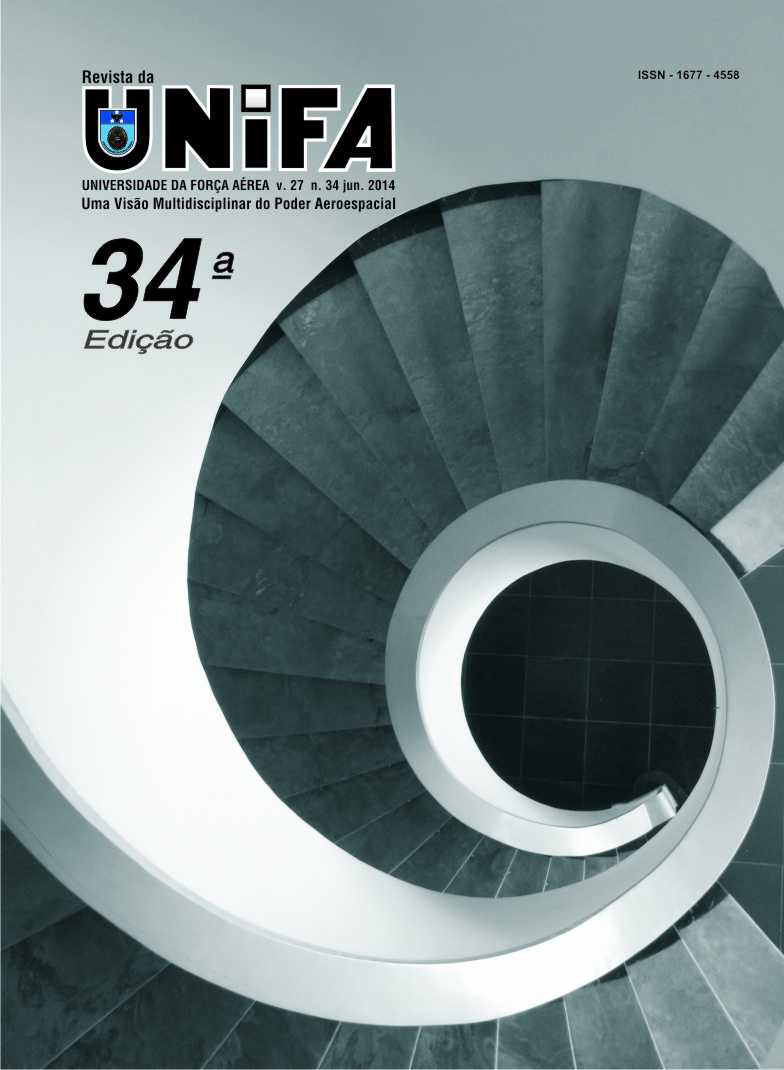The Influence of Aerobic Conditioning and Body Mass Index on Cardiovascular Risk
a study in military personnel of the 2011 Air Force Command and General Staff Course
DOI:
https://doi.org/10.22480/revunifa.2014.27.564Keywords:
Cardiovascular Risk, Aerobic Conditioning, Body mass index, Military medicineAbstract
This research investigated the relationship between the degree of Aerobic Conditioning (AC) and the individual risk for the development of cardiovascular diseases - Cardiovascular Risk (CVR) - in the group of 88 students of the Command and General Staff Course of the Air Force of 2011. The RCV stratification of the sample was performed according to the Framingham risk score. The method assigns to each individual scores proportional to the presence and magnitude of certain risk factors, estimating their CVR in the next 10 years. According to this methodology, using data from the last annual health inspection of the studied group, 44 students presented CVR < 5%, 41 between 5 and 9% and 3 had CVR > 10%. The WC was evaluated through the performance in the ergometric test. Obtained excellent WC, 55 individuals; CA good, 30; Regular or weak AC, 3. In order to draw a parallel with a variable known to be linked to cardiovascular diseases, the body mass index of the sample was also evaluated, relating the CVR with the body weight parameters found. We computed 26 students in the normal weight range, 43 with overweight and 19 with obesity parameters. No significant difference was found (p>0.05) regarding CVR between individuals with excellent aerobic performance and the others, in contrast to the CVR observed in overweight/obese individuals, significantly higher than that found in the ideal weight group.
References
AMERICAN COLLEGE SPORTS MEDICINE Guidelines for Exercise Testing and Prescription. 6. ed. Philadelfia: Lippincott Willians & Wilkins, 2000.
AZAMBUJA, M. I. et al. Impacto econômico dos casos de doença cardiovascular grave no Brasil: uma estimativa baseada em dados secundários. Arquivos Brasileiros de Cardiologia, v. 88, n. 91, n. 3, set. 2008.
BLAIR, S. N., et al. Is physical activity or physical fitness more important in defining health benefits? Medicine Science Sports Exercise, v. 33, n. 6, p. 379-399, 2001.
BRANDÃO, A. P. I Diretriz brasileira de diagnóstico e tratamento da síndrome metabólica. Arquivos Brasileiros de Cardiologia, v. 84, Suplemento I, abr. 2005.
BRASIL. Ministério da Saúde. Cadernos de prevenção básica, v. 14, 2006. Disponível em: <http://bvsms.saude.gov.br/bvs/publicacoes/
abcad14.pdf>. Acesso em: 02 mai. 2011.
BRAUNWALD, E. A textbook of cardiovascular medicine. 8. ed. Philadelphia: Saunders Elsevier, 2008.
BRITO, F. B. et al. II diretrizes brasileiras sobre teste ergométrico. Arquivos Brasileiros de Cardiologia. v. 78, Suplemento I, abr. 2002.
COOPER, Kenneth H. Programa aeróbico para o bem estar total. 3. ed. Rio de Janeiro: Melory, 1990.DEMETRA, D. C. et al. Fitness is a better predictor of cardiovascular disease risk factor profile than aerobic fitness in healthy men. Circulation, 2005. Disponível em: <http://circ.ahajournals.org/content/111/15/1904.abstract>. Acesso em: 02 jul. 2011.
DIAS, Elizabeth C. Doenças relacionadas ao trabalho: Manual de Procedimentos para os Serviços de Saúde. Brasília: Editora MS, 2001.
GIGANTE, D. P. et al. Prevalência de obesidade em adultos e seus fatores de risco. Revista de Saúde Pública, v. 31, n. 3, p. 236-46, 1997.
GODOY, M. F. et al. Mortalidade por doenças cardiovasculares e níveis socioeconômicos na população de São José de Rio Preto, São Paulo. Arquivos Brasileiros de Cardiologia, São Paulo, v. 88, n. 2, fev. 2007.
LOTUFO, Paulo A. O escore de risco de Framingham para doenças cardiovasculares. Revista da Associação Médica de São Paulo, v. 87, p. 232-237, dez. 2002.
MAFRA, F.; OLIVEIRA, H. Avaliação do risco cardiovascular – metodologias e suas implicações na prática clínica. Revista Port. Clinica Geral, v. 24, p. 391-400, 2008.
MERELE, C. J. Manual de Fisiopatologia. 2. ed. São Paulo: Roca, 2007.
PEREIRA, et al. Obesidade: hábitos nutricionais, sedentarismo e resistência à insulina. Arquivo Brasileiro de Endocrinologia Metab, v. 47, p. 111-27, 2003.
PITANGA, F. J. G; LESSA, I. Associação entre indicadores antropométricos de obesidade e risco coronariano em adultos na cidade de Salvador, Bahia, Brasil. Revista Brasileira de Epidemiologia, v.10, n. 2, p. 239-248, 2007. Disponível em: <http://www.scielosp.org>. Acesso
em: 15 mai. 2011.
POLANCZYK, CARÍSI ANNE. Fatores de risco cardiovascular no Brasil: os próximos 50 anos. Arquivos Brasileiros de Cardiologia, v. 84, n. 3,
mar. 2005.
SANTOS, R. D. et al. Diretrizes para cardiologistas sobre excesso de peso e doença cardiovascular dos Departamentos de Aterosclerose, Cardiologia Clínica e FUNCOR da Sociedade Brasileira de Cardiologia. Arquivos Brasileiros de Cardiologia, v. 78, Suplemento I, p.1-14, 2002.
SPOSITO, Andrei C. et al. IV Diretriz brasileira sobre dislipidemias e prevenção da aterosclerose. Arquivos Brasileiros de Cardiologia, São Paulo, v. 88, n. 1, abr. 2007.
WILSON, PETER W. F. et al. Prediction of coronary heart disease using risk factor categories. Circulation, v. 12, p. 1837-74, 1998.
YUSUF, SALIM et al. Effect of potentially modifiable risk factors associated with myocardial infarction in 52 countries (the INTERHEART study): case-control study. Lancet, v. 364, p. 937-52, 2004
Downloads
Published
Issue
Section
License
Copyright (c) 2014 José Moacir Fonseca da Silva

This work is licensed under a Creative Commons Attribution-NonCommercial 4.0 International License.
Revista da UNIFA permite que o (s) autor (es) mantenha(m) seus direitos autorais sem restrições. Atribuição-NãoComercial 4.0 Internacional (CC BY-NC 4.0) - Revista da UNIFA é regida pela licença CC-BY-NC









